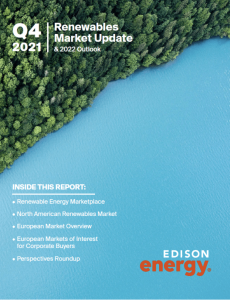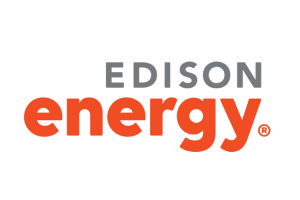Edison Energy’s Renewables Market Update predicts easing prices across sector
Report details supply chain and inflation impacts, sees easing price pressures, and a positive outlook for 2022
Though there are challenges in the renewables market today, corporate demand to bring new renewable energy projects online is ever-increasing.”
NEWPORT BEACH, CALIFORNIA, UNITED STATES, February 2, 2022 /EINPresswire.com/ -- Edison Energy LLC's newly published Renewables Market Update details the impacts of persistent supply chain challenges and inflationary pressure amid rising corporate demand for renewable power and environmental commodities. Though the renewables market is not likely to return to pre-pandemic normals anytime soon, developers are hopeful that macroeconomic constraints will ease to some degree by the end of 2022. — Mary Kate Francis, Senior Director of Energy Sourcing
“Though there are challenges in the renewables market today, corporate demand to bring new renewable energy projects online is ever-increasing,” Edison Energy Senior Director of Energy Sourcing Mary Kate Francis said. “At this time of ongoing uncertainty, buyers are seeing the value in contracting with mature projects that are nearly ready for construction so they can have greater confidence in achieving their renewable energy goals in their targeted timeframes.”
In the U.S.
The renewables industry is not immune to the supply chain challenges and inflationary pressures plaguing the broader economy. PPA prices rose across all markets and technologies due to macroeconomic factors such as increased commodities pricing, ending the year at their highest levels. During Q4 2021, Edison Energy saw p25 PPA price increases including solar in ERCOT, PJM, MISO, and SPP rising approximately $2-7/MWh. For regional grid specifics, see full report here.
Buyers with 2025 goals are under pressure to act swiftly, as project inventory is dominated by online dates in 2024 and beyond. As the calendar turned to 2022, many near-term projects were contracted and the anticipated online dates for the majority of the project inventory shifted to two years out and later.
Compared to the previous quarter, the number of projects on the market with 2024 online dates were up 10% to 68 projects, while projects anticipated to come online in 2025 and beyond were up 82% to 20 projects. Several factors drove the outward shift in anticipated project online dates, starting with supply and demand. During this time of macroeconomic pressures and uncertainties, some buyers are placing greater value on de-risked projects that are ready for construction in the near term, while at the same time developers face long development cycles with respect to interconnection timelines.
Concerns around tariffs and forced labor within the solar supply chain remained in the spotlight throughout 2021. Manufacturers, project developers, and energy buyers were impacted by these issues from an ethical as well as economic perspective in Q4 2021.
After a very volatile Q3, Q4 U.S. National REC pricing remained stable at around $4/REC, dependent on type and vintage. While this stability is likely a relief to buyers compared to the $7/REC pricing last August, it still reflects a significant difference in price and budget required when considering RECs compared to historic prices.
Carbon offset pricing continued to rise in response to demand and standard certainty, and in Q4, the carbon offset market officially reached a value of $1 billion – a new milestone in a market experiencing increased interest from voluntary buyers, and more notably, traders.
In Europe
In the European Renewables Market, Q4 saw a significant increase in PPA announcements. Corporate interest in meeting sustainability targets, driven in part by the energy crisis and skyrocketing gas prices, resulted in increased demand for renewable energy sourcing and Guarantees of Origin (GOs).
It also resulted in higher PPA prices across Europe, as developers started to see opportunities in selling power in spot markets. To align with this shift, developers began offering floating price structures as a way to de-risk projects. Spain maintained its position as the most attractive renewable energy market with competitive PPA pricing for solar energy projects, resulting in the largest number of volumes contracted there, followed by Germany. Poland saw undersupply but is expected to ease regulatory hurdles, Germany emerged as a market of interest for corporate procurement, and the Netherlands saw a growing offshore wind project pipeline. Emerging markets such as Croatia and Greece saw the launch of first-time, smaller PPAs.
The European GO market has mirrored the turbulent pricing environment seen in other EU commodities, with pricing peaking in early October at an almost 3x increase from the start of the year. This price increase was due to an increase in GO trading, with the number of transactions and associated volumes increasing.
The carbon offset market broke records across both North America and Europe, with a surge in demand from both voluntary buyers and traders. Europe remains the most expensive offset market due to increased costs of development, project types, and a general scarcity of projects available due to most projects being advanced in the developing world. Q4 saw more clarity around carbon offset standards and usage, both in the voluntary and compliance space. The COP26 consensus around creating a singular standard market for carbon offsets is expected to create much-needed certainty and stability going forward.
General outlook for 2022
In the U.S., developers remain hopeful that pressures on PPA prices will ease in 2022. The solar supply chain saw some uncertainty resolved, although other challenges, such as concern over whether forced labor is being used in polysilicon manufacturing, persist. The majority of projects on the market offer online dates of 2024 and beyond, and de-risked projects are in demand and will likely go off the market quickly.
While uncertainty persists around whether the final version of the Build Back Better Act will become law, Edison Energy anticipates that this legislation would offer benefits to the renewable energy industry if passed. RECs are likely to remain in high demand and post COP26, the carbon offset market will move closer to a singular global standard. Removal offsets will see significant demand.
In regards to the regional transmission organizations, prospective buyers in PJM will need to act quickly or wait patiently, as queue reform aims to address prolonged interconnection study delays. Prospective buyers in ERCOT will need to contract around Texas energy market reform, which remains a continuing source of uncertainty in 2022.
In Europe, Edison Energy anticipates upward pricing pressure driven by surging demand for PPAs despite carbon price pressures on renewables. More insights here.
Peter L Kelley
RenewComm LLC
+1 202-270-8831
email us here


